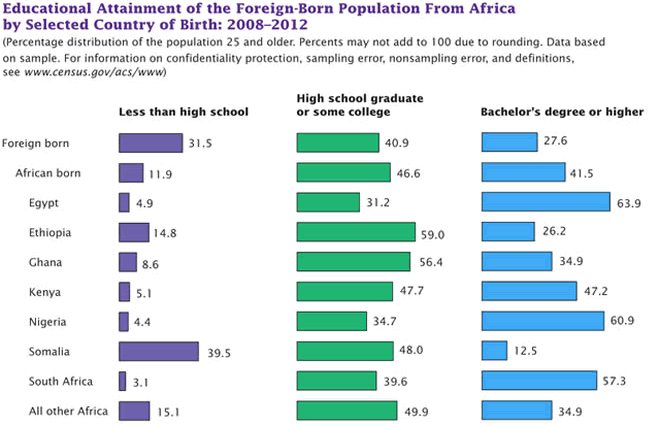
Graph: U.S. Census Bureau, 2008-2012 American Community Survey, 5-years estimates

Thursday, October 16, 2014
New York (TADIAS) – According to the U.S. Census Bureau’s latest American Community Survey 41% of the African-born population in the United States obtained bachelors degrees or higher between 2008 and 2012 compared with 28% of the overall foreign-born U.S. population.
The study, which was released this month, indicates a rapid population growth among the foreign-born African community in the United States. In the past two decades, the document says, many Africans came to America through the Green Card lottery system, which partially explains African immigrants’ higher educational level. “A relatively high proportion of immigrants from Africa entered the United States on diversity visas (24 percent as compared with 5 percent of the overall foreign born), which require a high school diploma or equivalent work experience,” the report states.
The survey gives a conservative estimate of the total number of African immigrants currently residing in U.S at less than 2 million. Nonetheless the census report, authored by Christine P. Gambino, Edward N. Trevelyan, and John Thomas Fitzwater, provides the most comprehensive and up-to-date data on the community. The document notes that between 2008-2012 there were “39.8 million foreign-born people that resided in the United States, including 1.6 million from Africa.” Since the 1970s, “during the following four decades, the number of foreign born from Africa grew rapidly, roughly doubling each decade.”
The report states that a vast majority of the foreign-born population from Africa migrated to the United States after 1990. “The timing of this movement was driven in part by historical changes. Outmigration from Africa increased rapidly after World War II, as migrants responded to the pull of educational opportunities and jobs abroad. While the first waves of postwar migrants went to other African countries and former colonial powers of Europe, migration to the United States increased in the 1970s as economies faltered and new restrictions were placed upon immigration in Western Europe. More immigrants from Africa were admitted to the United States after the U.S. Immigration Act of 1965, which replaced the national origin quota system favoring immigration from Europe with a new law prioritizing skilled labor, family unification, and humanitarianism. In addition, nearly a quarter of all immigrants from Africa to the United States in 2010 entered as refugees or received asylum as a result of ethnic conflict or civil war, particularly in countries such as Somalia, Liberia, and Sudan. The rate of African-born immigrants arriving and staying in the United States accelerated further as immigrant networks grew and pathways were established.”
In terms of geographic distribution, New York, California, Texas, and Maryland are listed as the top four states that are home to more than 100,000 residents from the African continent. “The largest African-origin countries for Washington DC were Ethiopia and Nigeria. The largest African-born populations in Minneapolis-St. Paul were from Somalia and Ethiopia. In Los Angeles and San Francisco, leading African countries of birth included Egypt, Nigeria, and Ethiopia. The largest African-origin countries in the New York metropolitan area were Egypt and Ghana, each composing just under 20 percent of the total African born.”
In the Washington, DC, metro area the foreign-born populations was more than three times the national percentage (13 percent). In addition, several other U.S. cities are spotlighted as having pockets of African-born populations (between 20,000 and 35,000) such as Columbus, Ohio and Baltimore, Maryland. While Midwestern states like Minnesota are mentioned as magnets that attract East African immigrants including Ethiopians and Somalians, the West Coast numbers are below the national average: Los Angeles (1.5 percent), San Francisco (1.8 percent), and San Diego (2.2 percent).
“Of the 1.6 million foreign born from Africa in the United States the largest African-born populations were from Nigeria and Ghana in Western Africa; Ethiopia, Kenya, and Somalia in Eastern Africa; Egypt in Northern Africa; and South Africa in Southern Africa,” the report continued. “Of these seven, the four largest were Nigeria (221,000 or 14 percent of the African-born population), Ethiopia (164,000 or 10 percent), Egypt (143,000 or 9 percent), and Ghana (121,000 or 8 percent), together constituting 41 percent of the African-born total.”